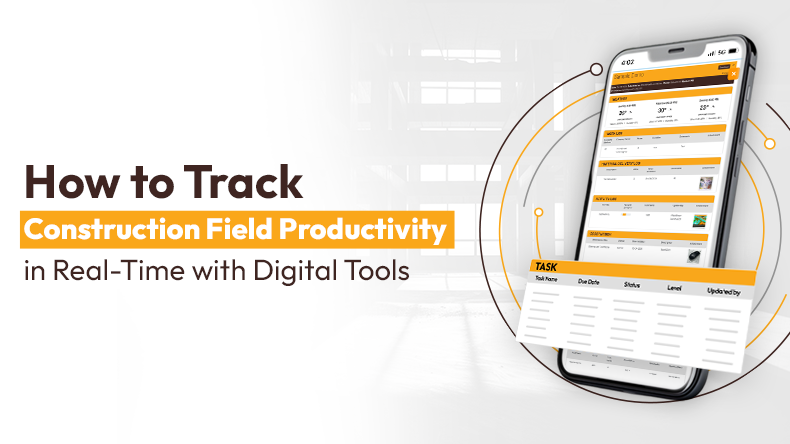Reading Time: 5 minutes
Introduction
Enhancements in field productivity are important to keep schedules on track, cut costs, and enable high-performance outcomes. In the absence of the right workflows, data, and tools, quantifying performance can create hurdles. That’s the reason stakeholders need to monitor construction field productivity metrics. These include job site performance KPIs, which explain how construction materials, labor, and equipment are being deployed, and where ambiguities are present.
The following article explains the need for productivity metrics for every stakeholder included in the project. This data also provides key insights to improve project execution using construction performance data.
Tracking Efficiency and Resource Productivity
Significance
Job site personnel or labor create costs that keep fluctuating. Monitoring labor productivity identifies if job site individuals are working at the required output.
Work Smarter, Not Harder
iFieldSmart empowers your team with AI-driven efficiency to simplify scheduling, boost collaboration, and keep projects on track.
Schedule a MeetingTracking
You need to quantify the outcomes based on labor hours. Installing 1500 sq ft of drywall in 15 hours – productivity rate is 100 sq.ft./hour. Mobile apps and digital timecards can be used to track labor efficiency in construction. It helps participants track performance in real-time between various disciplines.
What are the different KPIs to look for?
- Number of labor hours per task.
- Number of units installed per hour.
- Monitoring actual vs % of planned labor hours.
Rate at Which Equipment Is Used
Significance
Equipment that is underutilized causes higher capital waste, while overuse of site equipment or machinery can create project breakdowns or delays. Tracking effective equipment hours is essential.
Tracking
Employing devices like IoT sensors and telematics documents various time phases – idle and run-time. It also helps capture maintenance information. Cross-referencing this with activity timelines can result in a precise calculation of efficiency.
What are the different KPIs to look for?
- Run-time utilization of the equipment in %.
- Downtime for maintenance.
- Use of actual fuel vs required output.
Compliance with Timelines
Significance
Delays in timelines elevate overhead and labor costs and create a negative impact on client trust. Monitoring schedule performance highlights the origin of project delays.
Tracking
The best way to track this metric include the comparison of baseline timelines vs actual completion dates based on milestones. Utilize construction performance data through scheduling tools and daily logs to highlight project lag.
What are the different KPIs to look for?
- Number of tasks completed on time – in %.
- Either behind schedule or ahead of schedule.
- Variance in schedules – Planned vs actual timelines.
Rate of Project Rework
Significance
Rework is one of the most common yet detrimental hurdles that jeopardize productivity through greater time consumption, material waste, and inefficient allocation of labor.
Tracking
This metric can be monitored by documenting various flaws, change orders, and punch list components utilizing field reports or QMS. We need to calculate the effect based on cost and time.
What are the different KPIs to look for?
- What is the % of rework required?
- What is the amount of time lost to perform rework?
- What costs have been incurred during rework for every phase?
Efficiency Improvements by Controlling Material Use
Significance
Delays in delivering job site materials or ordering higher material quantities can impede project progress and elevate the cost of labor.
Tracking
This metric can be monitored for logistics schedules, efficiency of job site storage, and time used in relocating materials. You can utilize barcodes, RFIDs, or inventory monitoring platforms to make the material logistics process seamless.
What are the different KPIs to look for?
- Precision rate of material delivery.
- Time taken for delivering materials to the actual installation.
- The amount of material that is returned or wasted.
Recording Close Calls and Site Safety
Significance
Productivity is impacted by site risks. Job site incidents can close down operations, impair site equipment, and cause injuries to personnel.
Tracking
Tracking this metric can be achieved through field safety reports and logs monitoring. Stitching them with job site performance KPIs helps identify the frequency of incidents or their severity over a specific timeline.
What are the different KPIs to look for?
- Incident count per 1000 hours’ work performed.
- Frequency rate of close calls.
- Time utilized because of safety incidents.
Efficiency in Field Communication
Significance
Inconsistencies in communication cause flaws, delays, and resource waste. Consistent communication is essential for high performance.
Tracking
Can monitor this metric by evaluating Turnaround Times (TAT) for RFIs and response times to resolve issues. Using mobile construction management tools can help stakeholders log delays in construction.
What are the different KPIs to look for?
- Resolution time for RFIs.
- Problems resolved within 24 hours – in %.
- Communication gaps for each task.
Tracking Downtime for Crews
Significance
Personnel who do not perform on the job site cost money. Monitoring downtime supports closing timeline gaps, delays in material procurement, and resolution of coordination issues.
Tracking
Tracking this metric requires documenting unproductive hours and then classifying them using these parameters: material delays, weather, and failed equipment.
What are the different KPIs to look for?
- Downtime in 24 hours – in %.
- Avoidable delays cause lost hours.
- Calculating downtime based on categories.
Heading to a Conclusion
Optimizing job site productivity requires data-led tools like iFieldSmart Technologies. Monitoring the required job site performance KPIs, construction stakeholders can highlight ambiguities, enhance job site personnel and resources, and achieve efficient handovers. Using the required processes and toolset, construction firms can convert raw construction performance data into continuous enhancements in productivity and ROI.








